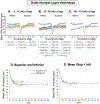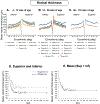In-vivo longitudinal changes in thickness of the postnatal canine retina
- PMID: 31931002
- PMCID: PMC7089710
- DOI: 10.1016/j.exer.2020.107926
In-vivo longitudinal changes in thickness of the postnatal canine retina
Abstract
The objectives of the present work were to assess by spectral domain optical coherence tomography (OCT) the changes in thickness of the outer nuclear layer (ONL), the ONL + photoreceptor inner segment (IS), and the retinal thickness, as a function of age in the normal canine retina. OCT retinal scans extending from the edge of the optic nerve head (ONH) along the superior and inferior meridians were captured in both eyes of 17 normal dogs at age ranging from 4 to 119 weeks. The different parameters along the superior and the inferior regions were determined following manual segmentation using the Heidelberg Eye Explorer software. Changes in thickness with age were modeled using one-phase exponential decay models. In vivo OCT imaging results showed no interocular statistically significant differences in ONL, ONL + IS, and retinal thickness at any age. All three parameters were however found to be statistically significantly thicker in the superior vs inferior retina. A rapid thinning of the three layers occurs in both the superior and inferior retina between 4 and 12 weeks of age, before reaching a plateau at around 20 weeks of age. In conclusion, the ONL, ONL + IS, and retinal thickness of the normal canine retina decrease significantly during the first three postnatal months, and is likely attributed to an overall increase in the eye volume and tangential dispersion of the photoreceptor since early photoreceptor developmental cell death is very limited at that age. Establishment of the natural history of ONL, ONL + IS, and retinal thinning will allow a more accurate assessment of the progression of a retinal degenerative condition as well as facilitate the detection of positive rescue effect of novel retinal therapies evaluated in this large animal model.
Keywords: Canine retina; Growth and development; ONL + IS; Optical coherence tomography; Outer nuclear layer; Photoreceptors; Retinal thickness.
Copyright © 2020 Elsevier Ltd. All rights reserved.
Conflict of interest statement
Declaration of competing interest All authors have no conflicts of interest to disclose relating to this work.
Figures





References
-
- Aguirre GD, Rubin LF, Bistner SI, 1972. Development of the Canine Eye. Am. J. Vet. Res 33, 2399–2414. - PubMed
-
- Beltran WA, Cideciyan AV, Iwabe S, Swider M, Kosyk MS, McDaid K, Martynyuk I, Ying G-S, Shaffer J, Deng W-T, Boye SL, Lewin AS, Hauswirth WW, Jacobson SG, Aguirre GD, 2015. Successful arrest of photoreceptor and vision loss expands the therapeutic window of retinal gene therapy to later stages of disease. Proc. Natl. Acad. Sci 112, E5844–E5853. 10.1073/pnas.1509914112 - DOI - PMC - PubMed
Publication types
MeSH terms
Grants and funding
LinkOut - more resources
Full Text Sources

